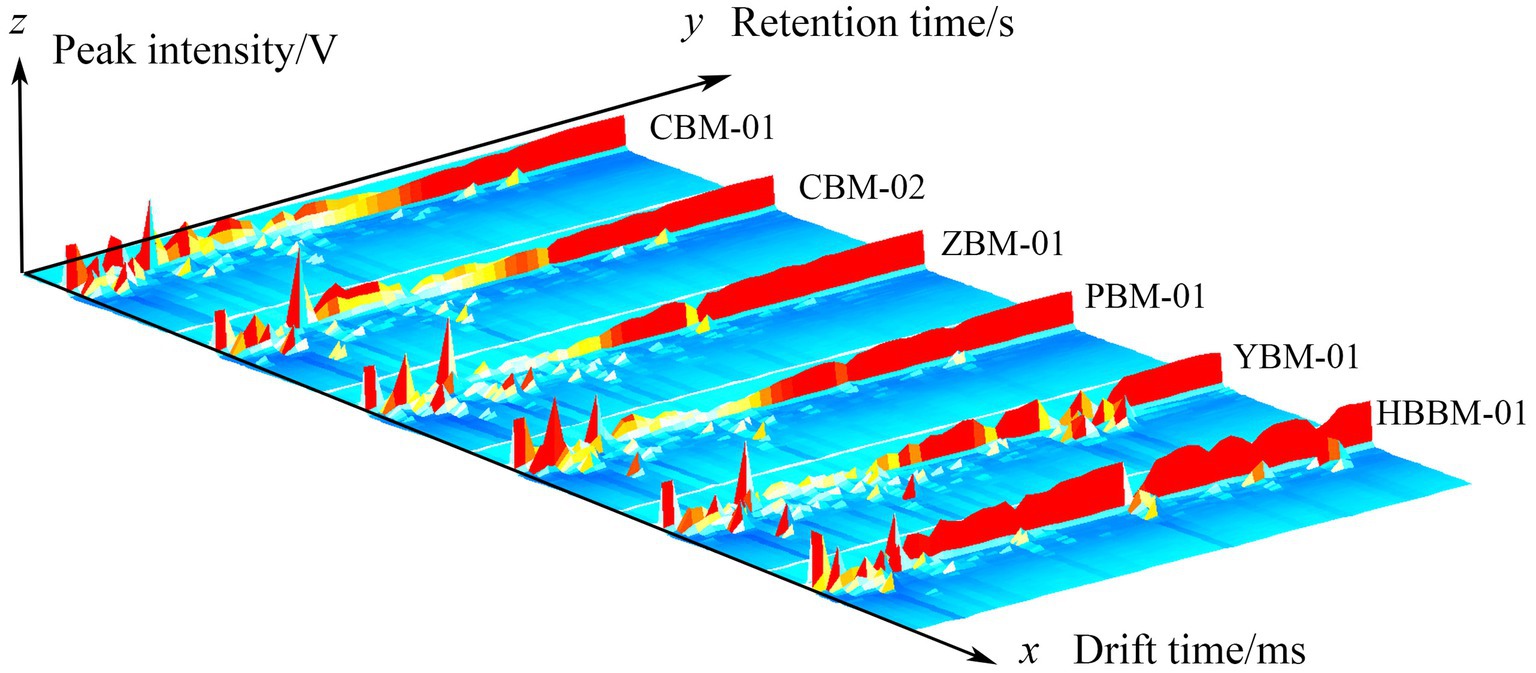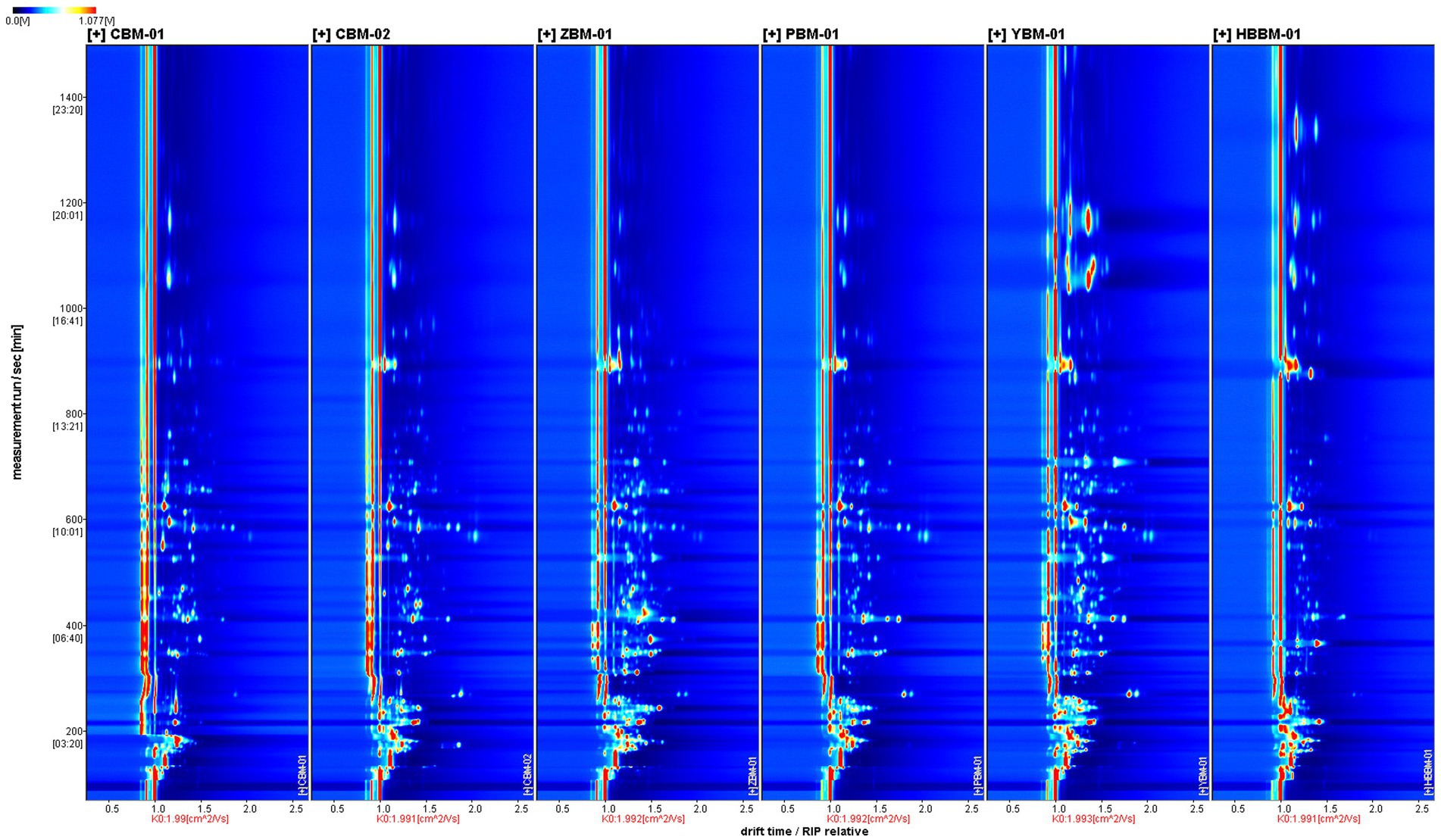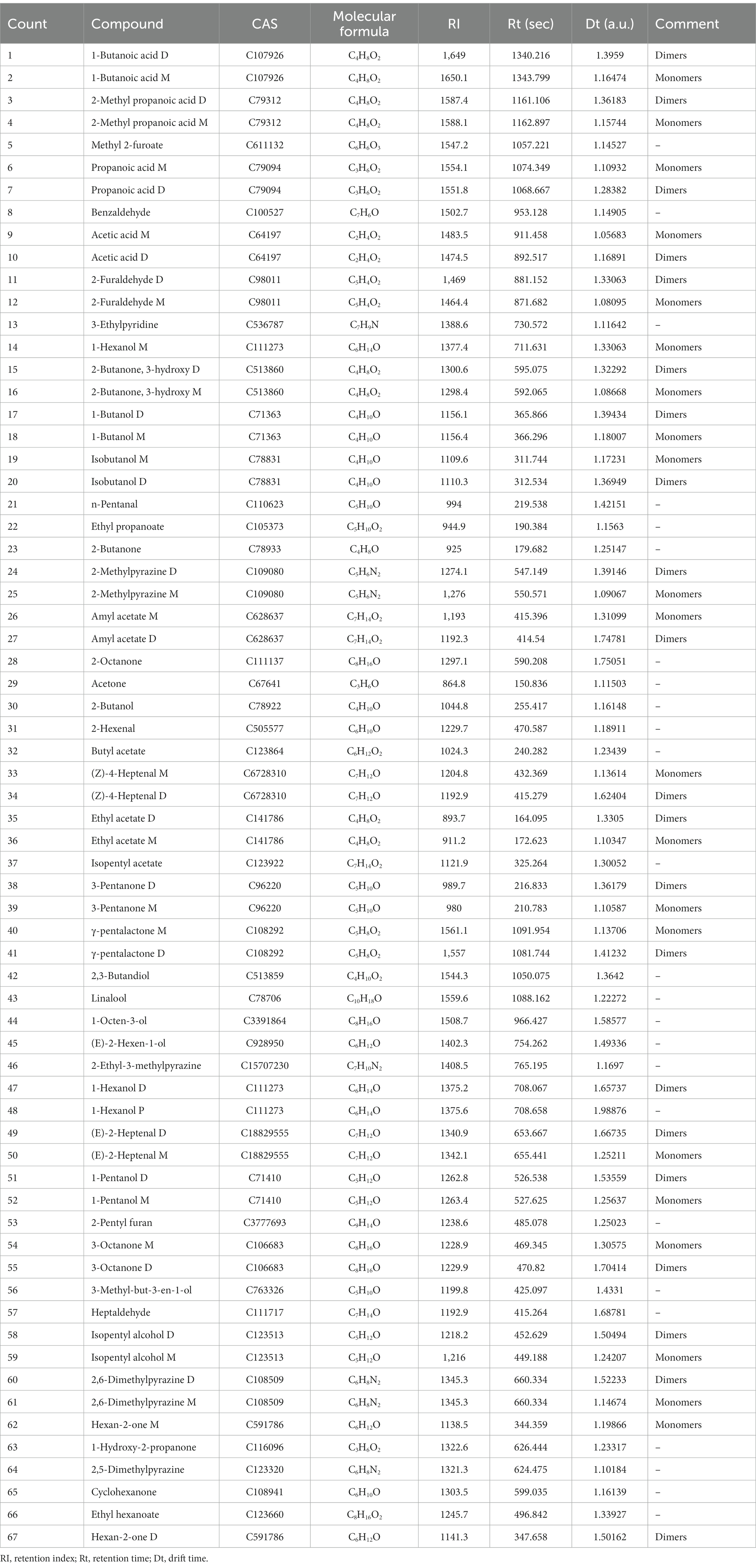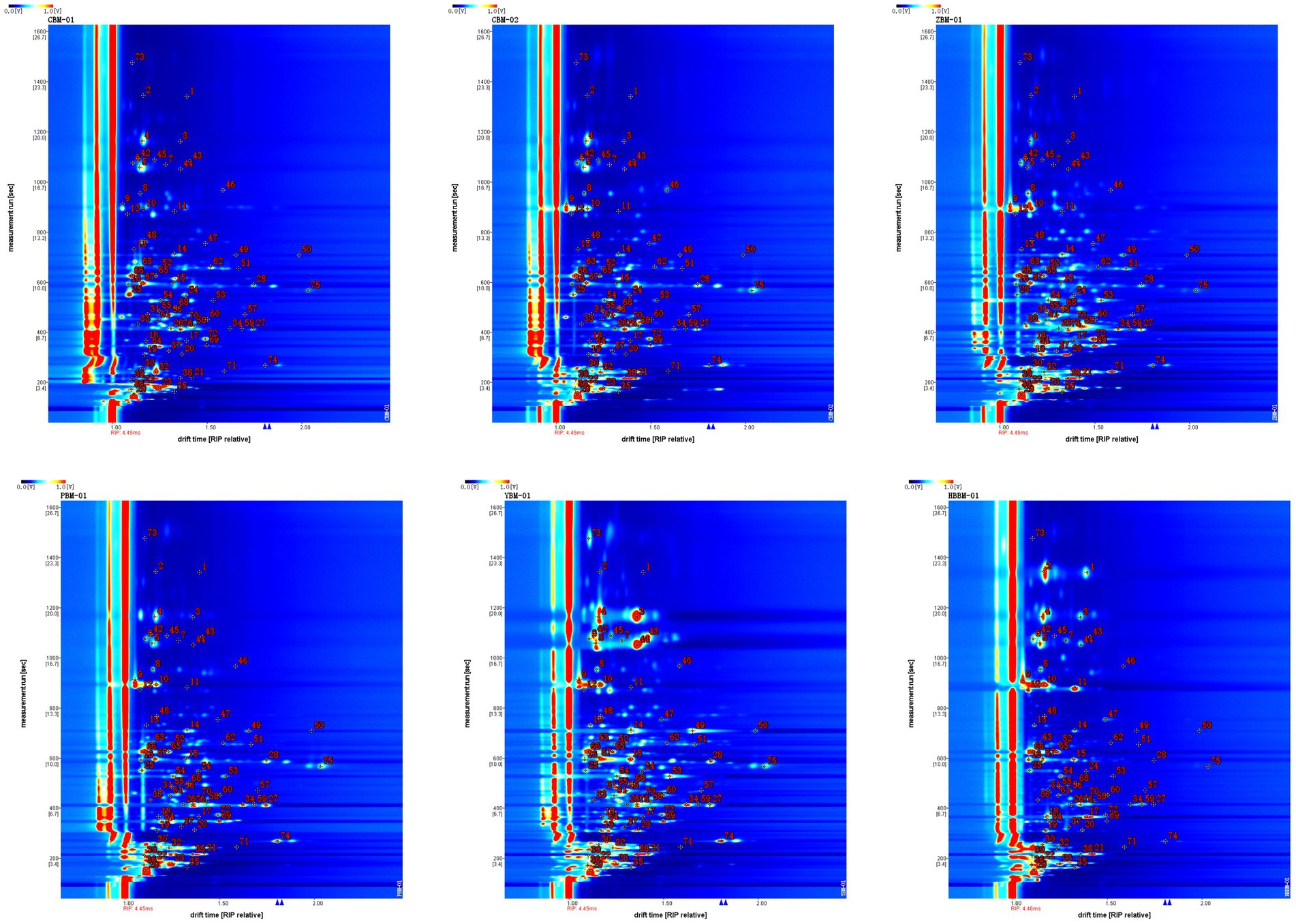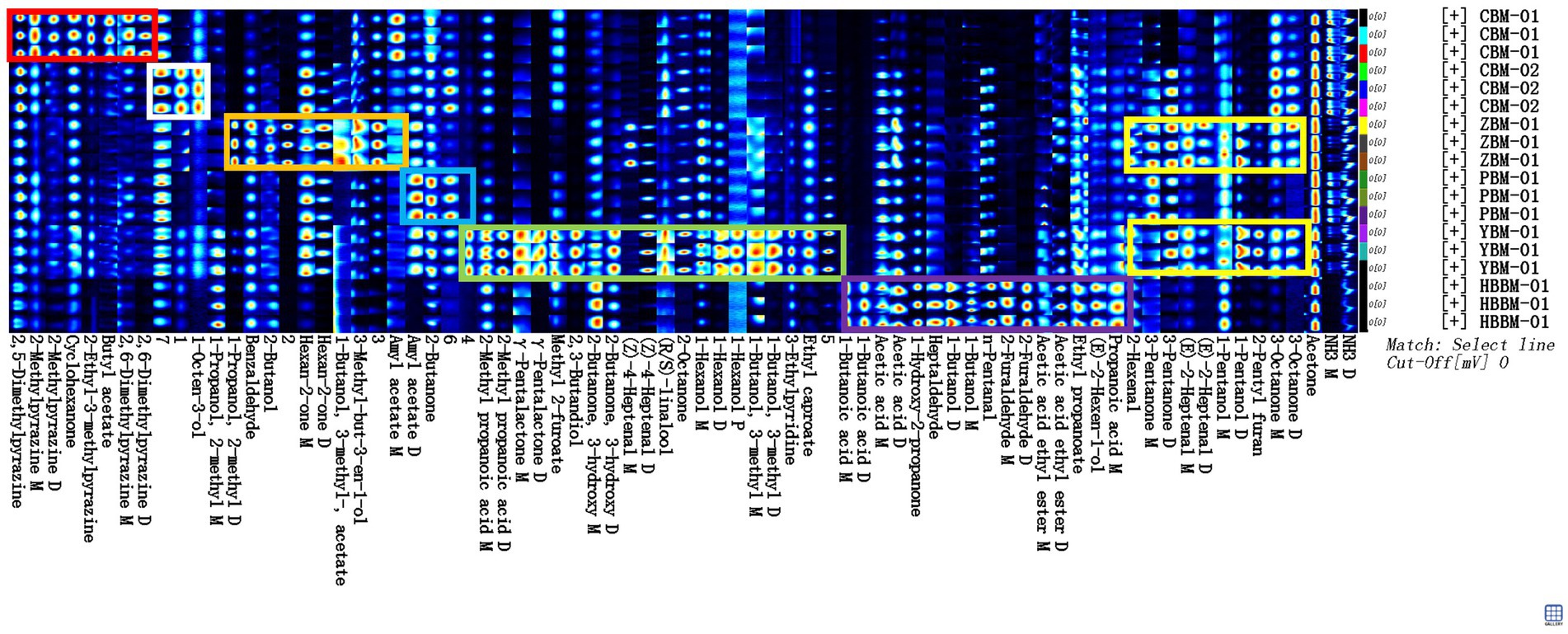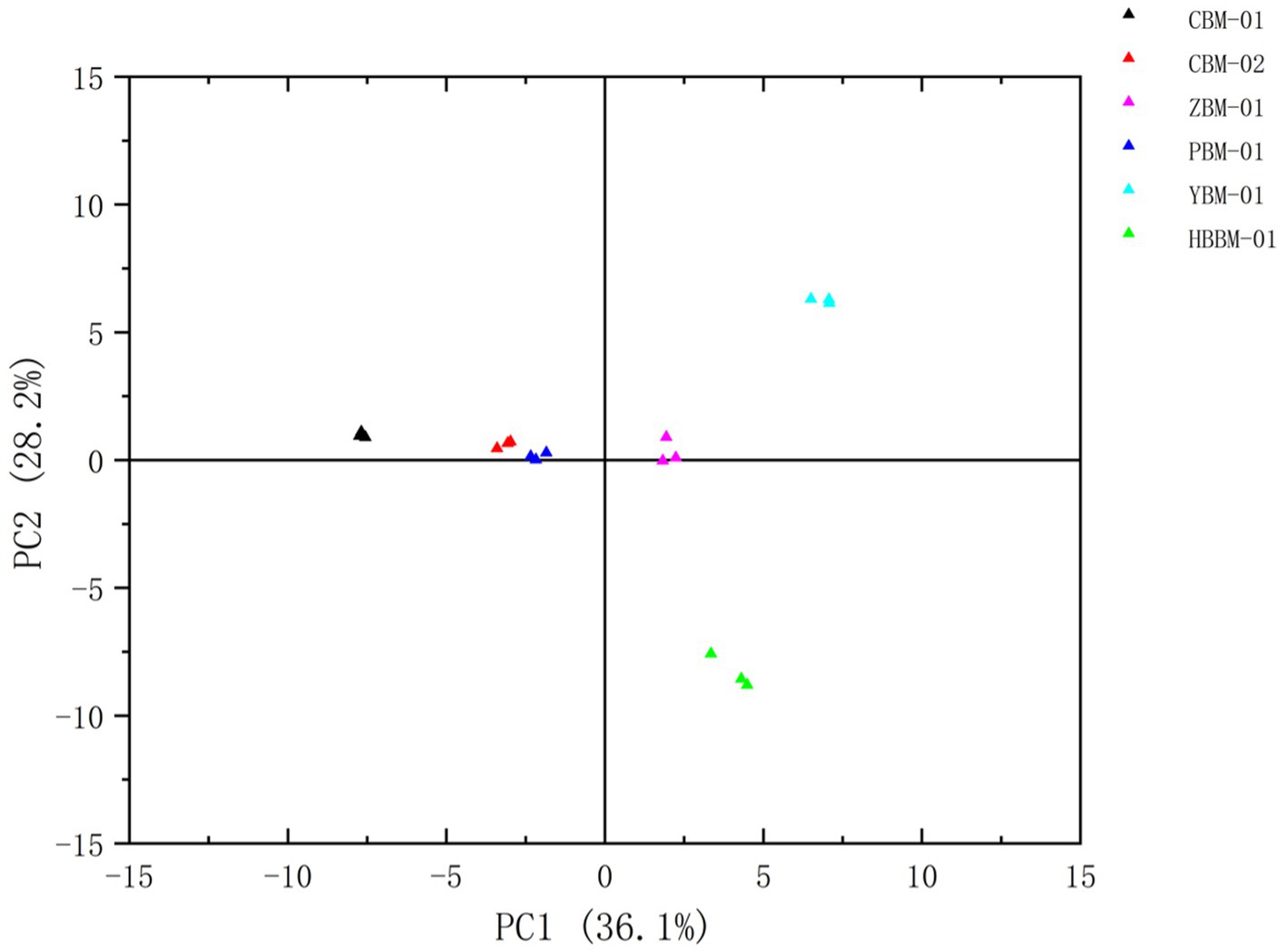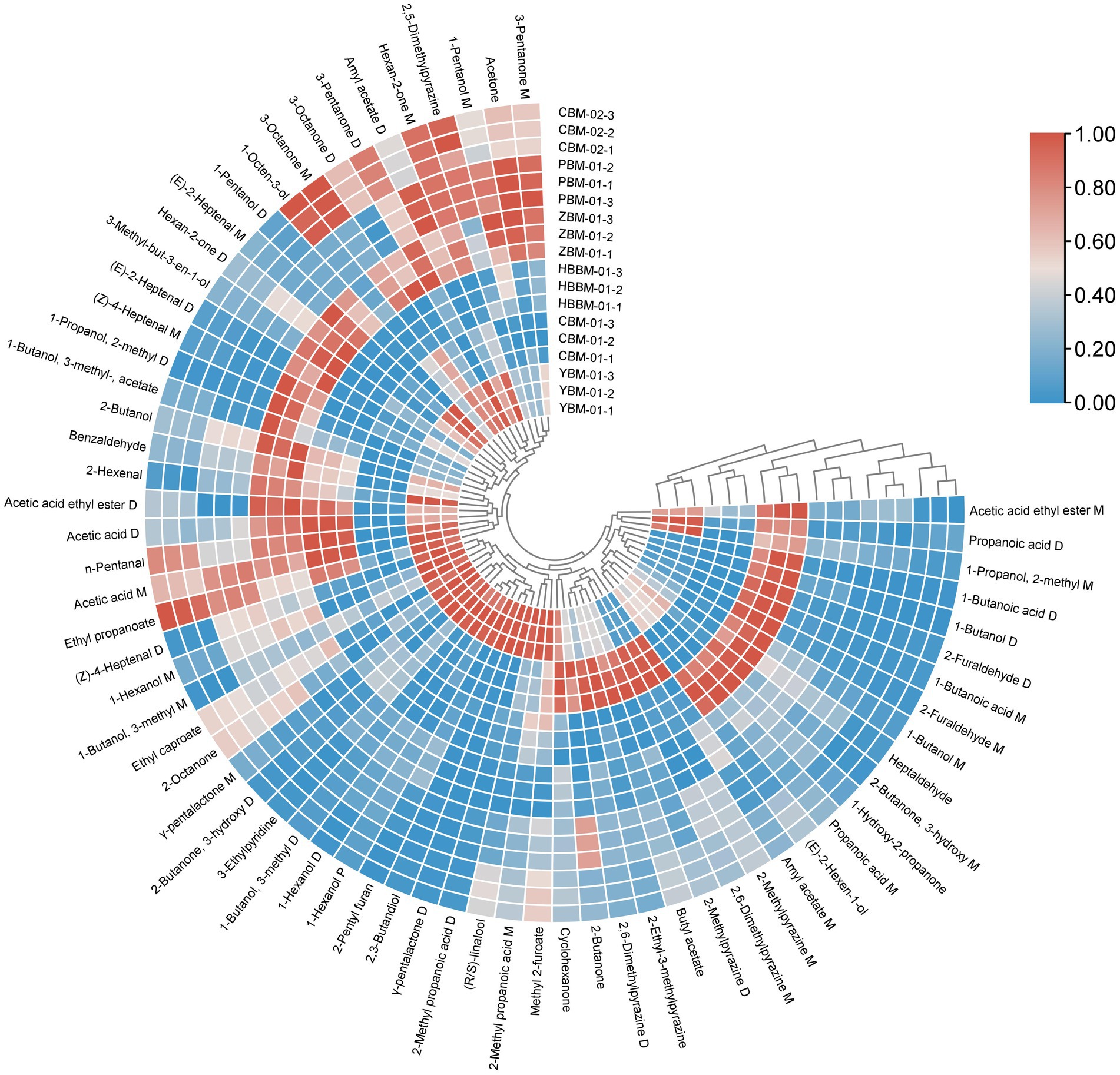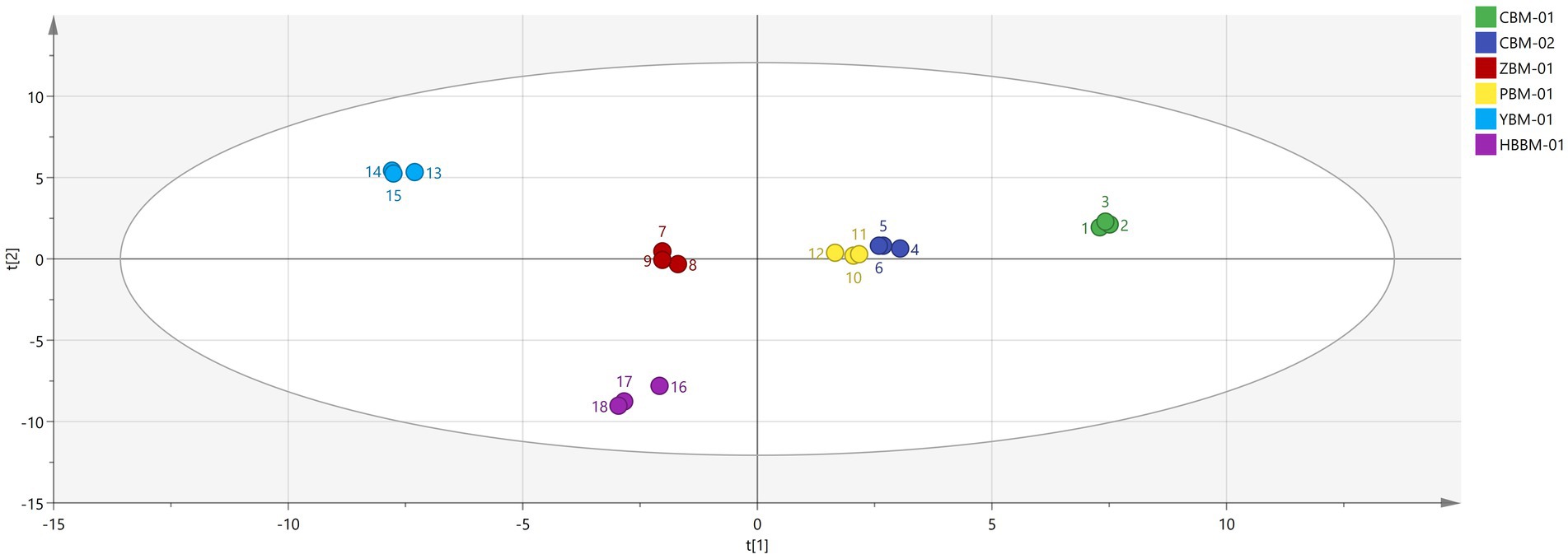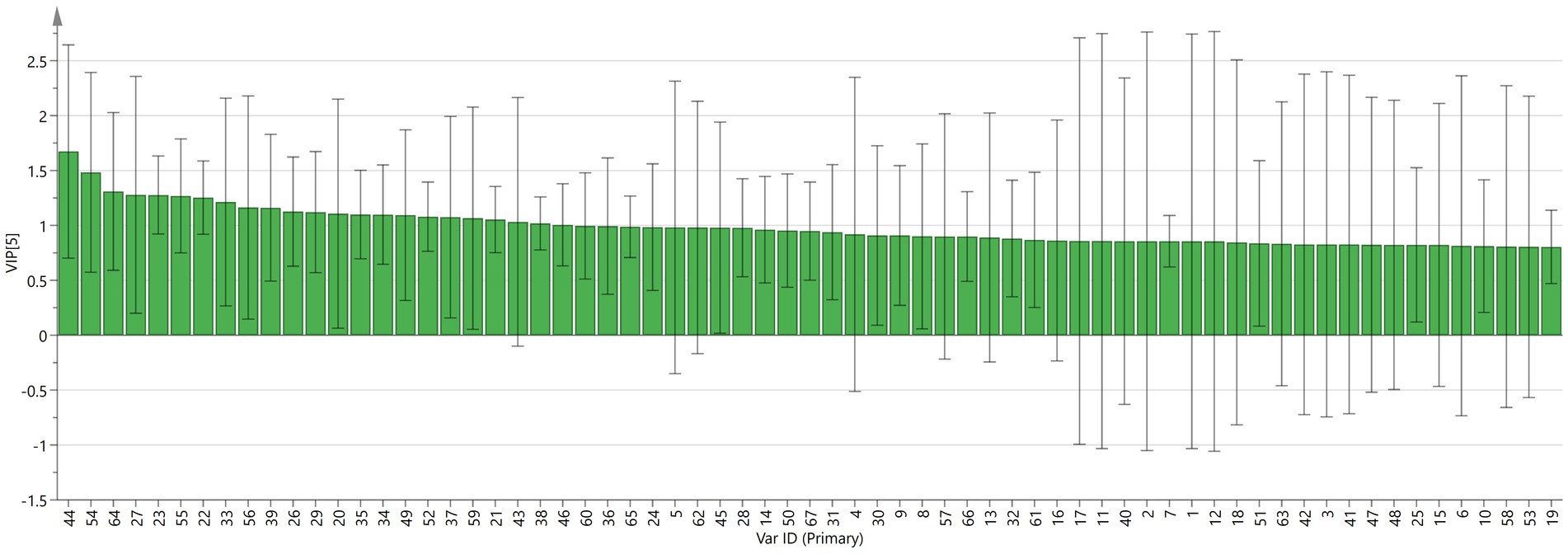Explorative study for the rapid detection of Fritillaria using gas chromatography-ion mobility spectrometry
- 1State Key Laboratory of Chinese Medicine Powder and Medicine Innovation in Hunan (Incubation), Science and Technology Innovation Center, Hunan University of Chinese Medicine, Changsha, China
- 2Hunan Fenghuang Lanke Traditional Chinese Medicine Co., Ltd., Changsha, China
- 3Hunan Engineering Technology Research Center for Bioactive Substance Dis-covery of Chinese Medicine, School of Pharmacy, Hunan University of Chinese Medicine, Changsha, China
- 4Chongqing Healn Drug Sales Co., Ltd., Chongqing, China
- 5Hunan Province Sino-US International Joint Research Center for Therapeutic Drugs of Senile Degenerative Diseases, Changsha, China
Fritillaria is a well-known health-promoting food, but it has many varieties and its market circulation is chaotic. In order to explore the differences in volatile organic compounds (VOCs) among different varieties of Fritillaria and quickly and accurately determine the variety of Fritillaria, this study selected six varieties of Fritillaria and identified and analyzed their volatile components using gas chromatography-ion mobility spectrometry (GC-IMS), establishing the characteristic fingerprints of VOCs in Fritillaria. In all samples, a total of 76 peaks were detected and 67 VOCs were identified. It was found that the composition of VOCs in different varieties of Fritillaria was similar, but the content was different. Combined with chemometric analysis, the differences between VOCs were clearly shown after principal component analysis, cluster analysis, and partial least-squares discriminant analysis. This may provide theoretical guidance for the identification and authenticity determination of different varieties of Fritillaria.
1 Introduction
Fritillaria is a well-known health-promoting food. Popular Fritillaria -based foods including Fritillaria chicken soup, Fritillaria pear paste and Fritillaria wine, have been gradually developed in the world. It belongs to the Liliaceae family, and there are about 130 species around the world; it is widely distributed in temperate regions of the northern hemisphere, especially in Central Asia, North America, and the Mediterranean region. There are about 40 species of Fritillaria in China, mainly distributed in Sichuan, Zhejiang, Gansu, Xinjiang, and Hubei and other places. It was recorded in the classis Chinese medicine work “Shen nong’s Herbal Classis” more than 2,000 years ago. Fritillaria tastes hot and flat, and is mainly used to treat cold and fever, drenching, hernia paralysis, laryngeal paralysis, lactation, and wind spasms. Modern research shows that it has antitumor (1, 2), antioxidant (3, 4), and antibacterial effects (5), and prevents neuropathies such as Alzheimer’s disease (6).
The current 2020 edition of the Chinese Pharmacopoeia contains eight herbs of the genus Fritillaria, which are categorized as Fritillariae cirrhosae bulbus, Fritillariae thunbergh bulbus,Fritillariae ussuriensis bulbus,Fritillariae pallidiflorae bulbus,and Fritillariae hupehensis bulbus (7). General Fritillariae cirrhosae bulbus is bittersweet and slightly cold, mostly used for deficiency coughs (8–12); Fritillariae thunbergh bulbus is bitter cold, mostly used for external coughs (13), which, in the clinical sense, is labeled “Chuanbeimu” and “Zhebeimu” according to the corresponding evidence; and Fritillariae ussuriensis bulbus (14) and Fritillariae pallidiflorae bulbus have the same efficacy as Fritillariae cirrhosae bulbus (15). Fritillariae hupehensis bulbus is used for coughs due to heat-phlegm, and for subcutaneous nodule scrofula. It can be seen that different varieties of fritillaria directly affect its quality, thus affecting its clinical efficacy (16).
Due to the special growth environment of Fritillariae cirrhosae bulbus, its growth is slow, and existing wild resources have been overharvested; however, there has been no breakthrough in artificial planting technology, resulting in the scarcity of genuine Fritillariae cirrhosae bulbus which cannot meet the market demand, prompting prices to soar. In addition, the market contains a wide range of Fritillaria medicinal materials with complex sources and similar appearances. In some cases, the cheaper species of Fritillaria (such as Fritillariae thunbergh bulbus,Fritillariae ussuriensis bulbus,Fritillariae pallidiflorae bulbus,Fritillariae hupehensis bulbus, and so on) are adulterated or sold as Fritillariae cirrhosae bulbus in order to obtain higher profits. This seriously affects the market order, jeopardizes the interests of consumers, and affects the safety and efficacy of medication. Therefore, it is very meaningful to establish an objective, scientific, accurate, and rapid method to identify different species of Fritillaria and adulteration problems (17).
At present, research into Fritillaria identification mostly uses feature and microscopic identification, DNA barcoding technique, high-performance liquid chromatography fingerprinting, etc. feature identification and microscopic identification is fast, but requires skill, and it is subjective, while DNA barcoding technique identification and high-performance liquid chromatography fingerprinting is precise and accurate, but the process is cumbersome and demanding on operators, takes a lot of time, and is expensive (18, 19).
Gas chromatography-ion mobility spectrometry (GC-IMS) is a fast and highly efficient analytical instrument that can operate under ambient pressure and temperature. It combines the strong separation capability of GC with the advantages of the high sensitivity and high resolution of IMS, which provides richer chemical information and more comprehensive analysis of compounds, as well as fast analysis speed with less sample dosage, and provides convenient conditions for the detection of samples with only trace amounts. Highly efficient and convenient conditions are provided for the detection of samples that can only be obtained in minute quantities (20). GC-IMS is now used in the fields of foods, odor analysis and environmental testing (21–24). In addition, GC-IMS technology is used to provide certain theoretical references for the identification, quality evaluation and production of medicinal herbs (25–28). Different varieties have certain differences in the types and contents of their compounds. Fritillaria contains a variety of VOCs, given that GC-IMS technology has the ability to efficiently analyze volatile substances, we predict that the type of Fritillaria can be quickly identified by analyzing the distribution and relative content of various VOCs in caladium by GC-IMS. In addition, identification accuracy is further improved by effectively identifying and quantifying various compounds. However, few studies have been reported on the identification of different species of Fritillaria using GC-IMS with Chemometric. Therefore, it is necessary to systematically and comprehensively analyze VOCs in different types Fritillaria under new technologies.
In this study, VOCs in different species of Fritillaria were studied with GC-IMS. Principal component analysis (PCA), cluster analysis (CA), and Partial least-squares discriminant analysis (PLS-DA) were used to analyze the differences of VOC odor fingerprints in different varieties of Fritillaria. The characteristic VOCs in different varieties of Fritillaria were displayed in a visual form, thus laying a certain foundation for rapid identification of Fritillaria in different species. This will be helpful to ensure the quality of Fritillaria and ensure the safety and effectiveness of medication for patients.
2 Materials and methods
2.1 Materials
The powders of the six kinds of Fritillaria were purchased from the National Institutes for Food and Drug Control, Beijing, China: Tendrilleaf Fritillary Bulb (the dried bulb of Fritillaria cirrhosa D. Don, No. 121757-202101, named CBM-01; the dried bulb of Fritillaria unibracteata Hsiao et K. C. Hsia, No. 121000-201609, named CBM-02); Thunberg Fritillary Bulb (the dried bulb of Fritillaria thunbergii Miq, No. 120972-201906, named ZBM-02); Ussuri Fritillary Bulb (the dried bulb of Fritillaria ussuriensis Maxim., No. 120924-201711, named PBM-01); Sinkiang Fritillary Bulb (the dried bulb of Fritillaria walujewii Regel, No. 121739-201701, named YBM-01); and Hubei Fritillary Bulb (the dried bulb of Fritillaria hupehensis Hsiao et K. C. Hsia, No. 120962-201005, named HBBM-01).
2.2 GC-IMS methods
2.2.1 Sample preparation
The powders of the samples were accurately weighed out to 1 g and placed into a 20 mL headspace vial, then incubated at 80°C for 15 min.
2.2.2 Headspace conditional
Static headspace autosampler unit (CTC-PAL 3), (CTC Analytics AG, Zwingen, Switzerland); injection volume: 500 μL; non-shunt injection; speed: rotation speed of 500 rpm for 20 min; injection needle temperature: 85°C.
2.2.3 GC conditional
A chromatographic column of MXT-WAX (15 m × 0.53 mm, 1.0 μm, Restek Inc., United States) was used. Column temperature: 60°C; carrier gas: high-purity N2 (purity ≥99.999%); programmed boosting: initial flow rate of 2.00 mL/min was held for 2 min, linearly increased to 10.00 mL/min within 8 min, linearly increased to 100.00 mL/min within 10 min, and held for 10 min. Chromatographic runtime: 30 min; injection temperature: 80°C. Run time: 30 min; inlet temperature: 80°C.
2.2.4 IMS conditional
GC-IMS instrument: FlavourSpec® Gas Phase Ion Mobility Spectrometer, G.A.S. (Dortmund, Germany); ionization source: tritium source (3H); drift tube length: 53 mm; electric field strength: 500 V/cm; drift tube temperature: 45°C; drift gas: high-purity N2 (purity ≥99.999%); flow rate: 150 mL/min; positive ion mode.
2.3 Statistical analysis
Preliminarily, the peaks of the samples were chosen and compared using the Laboratory Analytical Viewer (v.2.2.1, G.A.S.) and Reporter analysis (v.1.2.12, G.A.S.). We performed quantitative analysis using Gallery Plot Analysis (v.1.0.7, G.A.S.) on selected signal peaks. The principal component analysis (PCA) was performed in Origin software (Northampton, Massachusetts, United States), TBtools was used for cluster analysis and partial least-squares discriminant analysis (PLS-DA) of volatile profiles was performed in SIMCA software (Umea, Sweden).
To compare VOCs among samples, Reporter, Gallery Plot, and other plug-ins in VOCal data processing software were used to generate three-dimensional spectra, two-dimensional spectra, difference spectra, and fingerprints.
3 Results and discussion
3.1 Qualitative analysis of Fritillaria samples from different species
The three-dimensional(3D) GC-IMS spectra of different varieties of Fritillaria are shown in Figure 1. The three coordinates represent the drift time, retention time, and signal peak intensity, respectively, from which we can visualize the differences in VOCs of different varieties of Fritillaria. Figure 2 shows a comparison of the differences: the background of the whole image is blue, the red vertical line at 1.0 of the horizontal coordinates represents the RIP (reactive ion peak: represents the total amount of available ions formed), each point on both sides of the RIP represents one VOC, and the color represents the peak intensity of the substance. From blue to red, the darker the color, the greater the peak intensity, and it can be seen that there are certain differences in the VOCs from the samples of different types of Fritillaria. In order to further visualize and compare the differences in volatile components, the spectrum of the CBM-1 sample was selected as a reference, and the spectra of other samples were deducted from the reference to obtain a comparison of the differences between different samples, as shown in Figure 3. If the VOC contents in the target sample and the reference were the same, the background after deduction was white, while a red color means that the concentration of the substance was higher than the reference in the target sample, and a blue color means that the concentration of the substance was lower than the reference in the target sample.
3.1.1 Comparison of differences in volatile components of CBM-01 and CBM-02 samples
Using the comparison chart of the difference in VOCs of the CBM-01 and CBM-02 samples, it can be seen that there was also a significant difference in the VOCs. Although they are all named Tendrilleaf Fritillary Bulb, different origins, cultivation methods, and storage times may affect the content of some volatile substances.
3.1.2 Comparison of the differences in VOCs between Tendrilleaf Fritillary Bulb and other varieties of Fritillaria
The VOCs in all varieties of Fritillaria were analyzed using GC-IMS and well separated. The composition of the VOCs in different varieties of Fritillaria was similar, but there were significant differences in the contents. This may also be related to the fact that different varieties of Fritillaria can exert different medicinal effects.
3.2 Identification of VOCs in different Fritillaria samples
After GC-IMS analysis, a total of 76 substances were detected, and two-dimensional characterization was carried out using the NIST2020 gas-phase retention index database built in the Practical Vocal software and the IMS drift time database of G.A.S. The results of the GC-IMS analysis are shown in Table 1 and Figure 4.
According to Table 1, it can be seen that the content of the same VOCs differed significantly in different varieties of Fritillaria samples. Combined with the analysis of Table 1 and Figure 4, it can be concluded that a total of 67 VOCs were detected in six varieties of Fritillaria samples, including acids, ketones, esters, alcohols, aldehydes, furans, and pyrazine. This includes the monomers and dimers of some of the substances, in which the monomers and dimers identified had the same chemical formulas and CAS numbers, and only differed in their morphology.
3.3 Fingerprint spectrum analysis of Fritillaria samples from six different species
Figure 5 shows the fingerprints of the VOCs in six samples of Fritillaria. Each row in the figure represents all the signal peaks selected in one sample, and each column represents the signal peaks of the same VOCs in different samples.
Comparative analysis of VOCs in samples CBM-01, CBM-02, ZBM-01, PBM-01, YBM-01, and HBBM-01 showed that, as shown in the red box, 2,5-dimethylpyrazine, 2-methylpyrazine, cyclohexane, 2-ethyl-3-methylpyrazine, butyl acetate, and 2,6-dimethylpyrazine were present in sample CBM-01 in higher levels. As shown in the white box, unknown peak 1, unknown peak 7, and 1-octen-3-ol were higher in the CBM-2 sample. As shown in the orange box, 2-methylpropanol, 2-butanol, unknown peak 2, hexan-2-one, isoamyl acetate, 3-methyl-but-3-en-1-ol, unknown peak 3, and benzaldehyde were higher in ZBM-1. As shown in the blue box, amyl acetate, 2-butanone, and unknown peak 6 were higher in the PBM-01 sample. As shown in the green box, unknown peak 4, 3-ethylpyridine, 2-methylpropionic acid, γ-pentalactone, 2-butanone,3-hydroxy, 2,3-butanedione, methyl 2-furoate, (Z)-4-heptenal, linalool, 1-octen-3-ol, hexanol, 2-octanone, ethyl caproate, 3-methylbutanol, and unknown peak 5 were higher in the YBM-01 sample. As shown in the purple box, butyric acid, propionic acid, furfural, acetic acid, 1-hydroxy-2-propanone, heptanal, butanol, glutaraldehyde, ethyl acetate, ethyl propionate, and (E)-2-hexenol were higher in the HBBM-01 sample. As shown in the yellow box, 2-hexenal, 3-pentanone, (E)-2-heptenal, pentanol, 2-pentylfuran, and 3-octanone were higher in both the ZBM-01 and YBM-01 samples.
This shows that GC-IMS can form a unique fingerprint, visualize the differences of VOCs in different varieties of Fritillaria, and quickly distinguish and identify different varieties of Fritillaria.
3.4 Chemometric analysis
Chemometrics is an emerging branch of chemistry formed by the intersection of chemistry and mathematics, computer science, etc. It is of great significance in the quality control and research and evaluation of traditional Chinese medicine by establishing a link between the measured values of a chemical system and the state of the system through statistical or mathematical methods (29). The chemometric analysis of VOCs in different varieties of Fritillaria is helpful for finding the differential components to identify their varieties.
3.4.1 Principal component analysis
Principal component analysis (PCA) is a commonly used unsupervised analysis method which reduces the dimensionality of the data while retaining as much original information as possible and can respond to the overall situation of the chemical measurement data for complex traditional Chinese medicine systems (30). As shown in the Figure 6, the PCA of the VOCs in the six varieties of Fritillaria was performed, and the results are shown in Figure 6, which shows that the six groups of samples were well separated. When the samples are close to each other, it indicates that the difference in VOCs between the samples is relatively small, and on the contrary, it indicates that there is a significant difference in the VOCs between them. The distance between CBM-01 and the other Fritillaria was relatively large, which indicates that PCA can distinguish Fritillariae cirrhosae bulbus from the other varieties of Fritillaria very well. The distance between CBM-02 and PBM-01 was closer, which indicates that the difference in the VOCs between the two kinds of samples is small, similar to a previous study. These results indicated significant differences in VOCs among the six varieties and showed that the PCA could effectively distinguish the four other species of Fritillaria from Fritillariae cirrhosae bulbus.
3.4.2 Cluster analysis
Heat maps can be used to reflect data via color changes, which can visually represent the differences between data using color shades (31). As shown in the Figure 7, the 67 VOCs identified with GC-IMS were clustered and analyzed, and the differences in the VOCs of the six varieties of Fritillaria were clearer and more explicit, as shown in Figure 7. The clustering heat map shows that there are obvious differences in the VOCs in different varieties of Fritillaria (32). Among them, the contents of acetic acid and ethyl propanoate substances in CBM-01 were significantly less than those in other Fritillaria. The contents of (Z)-4-heptenal, 1-propanol, 2-methyl, 3-methyl-but-3-en-1-ol, and hexan-2-one substances were higher in ZBM-01 than in the other Fritillaria, while the contents of 1-hexanol, 2,3-butandiol, and 2-methyl propanoic acid substances were higher in YBM-01 than in the other Fritillaria. The contents of, 1-butanol, 2-furaldehyde, and 1-butanoic acid substances were higher in HBBM-01 than in the other Fritillaria.
3.4.3 Partial least-squares discriminant analysis
Partial least-squares discriminant analysis (PLS-DA) is a supervised pattern statistical analysis method that enables the visualization of complex data and is often used to deal with classification and discrimination problems (33). As shown in the Figure 8, to further explore the volatiles in different varieties of Fritillaria, PLS-DA modeling was performed with 69 VOCs identified as dependent variables and different varieties as independent variables. The results are shown in Figure 8. In this model, the six groups of samples were well separated from each other. The long distance between CBM-01 and other samples indicated that the VOCs of CBM-01 and other samples were significantly different. Meanwhile, a close distance between CBM-02 and PBM-01 samples can be observed, which is consistent with the results of PCA analysis.
The variable importance projection (VIP) indicates the strength of influence and explanatory ability of the differential components on the classification discrimination of various samples, which is an important index for screening differential compounds. The larger the VIP value of the sample, the more significant the variable is in distinguishing the sample. As shown in Figure 9, 1-Octen-3-ol, 3-Octanone, and 2,5-Dimethylpyrazine are the most important components that affect the difference of six varieties of Fritillaria (Figure 9).
4 Discussion
In this study, a total of 76 substances, including 67 VOCs were detected. Firstly, based on the GC-IMS odor fingerprint data, it was preliminarily found that the types of VOCs in different varieties of Fritillaria are similar, but there are significant differences in content. So, we further utilize chemometrics to analyze all the obtained data. The results of PCA and PLS-DA indicate that the distribution of VOCs in samples of different varieties is relatively independent, which also confirms Fritillariae ussuriensis bulbus is often used as a substitute for Fritillariae cirrhosae bulbus because of its high similarity to Fritillariae cirrhosae bulbus. Although its clinical effect is not as good as that of Fritillariae cirrhosae bulbus, it is of great significance to alleviate the shortage of resources of Fritillariae cirrhosae bulbus. Through the results of the heat map, it can be seen that there are components with higher content in different varieties of Fritillaria, such as CBM-01 contains a lot of pyrazine compounds, 1-Octan-3-ol having the highest content in CBM-02, and 3-Methyl-but-3-en-1-ol, 1-Butanol-3-Methyl acetate and other substances having the highest content in ZBM-01. The results of the heat map also mutually confirm the conclusions of the odor fingerprint spectrum. That’s also why Fritillariae thunbergh bulbus has better efficacy in relieving coughs and resolving phlegm than Fritillariae cirrhosae bulbus, Fritillariae pallidiflorae bulbus, and Fritillariae ussuriensis bulbus, which is related to the fact that it contains more bemacropodin A and bemacropodin B (34).
Compared with the traditional methods such as DNA barcoding technique and high-performance liquid chromatography (HPLC), the determination of VOCs in different Fritillaria samples via GC-IMS to differentiate between species has greatly improved the identification method and efficiency, and the pretreatment of samples is more efficient and convenient. It is very helpful for quickly identifying different varieties of Fritillaria.
5 Conclusion
In this study, the VOCs of six species of Fritillaria were analyzed and systematically compared using GC-IMS. A total of 79 peaks were detected, with 67 VOCs identified, mainly including acids, ketones, esters, alcohols, aldehydes, furans, and pyrazine. Among them, CBM-01 contains a lot of pyrazine compounds, with 1-Octan-3-ol having the highest content in CBM-02, and 3-Methyl-but-3-en-1-ol, 1-Butanol-3-Methyl acetate and other substances having the highest content in ZBM-01.
Based on statistical analysis with chemometrics, it was found that there were some differences in the ion migration spectra of different Fritillaria varieties. Fingerprints were established based on the characteristic components fitted by the graph plug-in software, and after principal component analysis (PCA), cluster analysis (CA), and partial least-squares discriminant analysis (PLS-DA), we could effectively and quickly distinguish Fritillariae cirrhosae bulbus and its common other Fritillaria species. This provides a new method for the quality control and identification of quality relationships of Fritillariae cirrhosae bulbus. This study demonstrates that GC-IMS provides an important reference value for the identification and authenticity assessment of different varieties of Fritillaria, which is conducive to ensuring the quality of Fritillaria in the market, thus guaranteeing the safety and effectiveness of medication.
Data availability statement
The original contributions presented in the study are included in the article/supplementary material, further inquiries can be directed to the corresponding authors.
Author contributions
YD: Conceptualization, Data curation, Formal analysis, Investigation, Methodology, Software, Supervision, Writing – original draft. ShaL: Conceptualization, Data curation, Formal analysis, Investigation, Methodology, Software, Supervision, Writing – original draft. LY: Conceptualization, Data curation, Formal analysis, Funding acquisition, Writing – original draft. YH: Conceptualization, Data curation, Writing – original draft. XG: Formal analysis, Resources, Validation, Writing – original draft. YM: Methodology, Supervision, Validation, Writing – original draft. ShuL: Funding acquisition, Project administration, Writing – original draft, Writing – review & editing. DH: Formal analysis, Funding acquisition, Resources, Software, Supervision, Writing – original draft, Writing – review & editing.
Funding
The author(s) declare financial support was received for the research, authorship, and/or publication of this article. This research was funded by the Special Development Project of Technical Innovation and Application in Chongqing (No. CSTC2021jscx-gksb-N0031), Key Discipline Project on Chinese Pharmacology of Hunan University of Chinese Medicine (202302), Department of Science and Technology of Xiangxi Tujiazu & Miaozu Autonomous Prefecture (No. 2022JSGG03), and Department of Science and Technology of Hunan Province (No. 2021CB1012). This study received funding from Chongqing Healn Drug Sales Co., Ltd. and Hunan Fenghuang Lanke Traditional Chinese Medicine Co., Ltd. The funders have the following involvement with the conceptualization, methodology, investigation, data curation, formal analysis, and writing – original draft and editing.
Conflict of interest
LY was employed by Chongqing Healn Drug Sales Co., Ltd. YD was employed by Hunan Fenghuang Lanke Traditional Chinese Medicine Co., Ltd.
The remaining authors declare that the research was conducted in the absence of any commercial or financial relationships that could be construed as a potential conflict of interest.
Publisher’s note
All claims expressed in this article are solely those of the authors and do not necessarily represent those of their affiliated organizations, or those of the publisher, the editors and the reviewers. Any product that may be evaluated in this article, or claim that may be made by its manufacturer, is not guaranteed or endorsed by the publisher.
References
1. Kardan, M, Yazdani, Z, Morsaljahan, Z, Ebrahimzadeh, MA, and Rafiei, A. Cytotoxic effect of methanolic extracts of Fritillaria imperialis bulbs and Eryngium caucasicum leaves on hepatoma and colon cancer cells. Asian Pac J Trop Biomed. (2019) 9:353–8. doi: 10.4103/2221-1691.262084
2. Liu, FJ, Chen, XY, Yang, J, Zhao, Z, Wang, QL, Li, P, et al. Revealing active components and action mechanism of Fritillariae Bulbus against non-small cell lung cancer through spectrum-effect relationship and proteomics. Phytomedicine. (2023) 110:154635. doi: 10.1016/j.phymed.2022.154635
3. Pan, F, Su, T, Liu, Y, Hou, K, Chen, C, and Wu, W. Extraction, purification and antioxidation of a polysaccharide from Fritillaria unibracteata var. wabuensis. Int J Biol Macromol. (2018) 112:1073–83. doi: 10.1016/j.ijbiomac.2018.02.070
4. Liu, S, Yang, T, Ming, TW, Gaun, TKW, Zhou, T, Wang, S, et al. Isosteroid alkaloids from Fritillaria cirrhosa bulbus as inhibitors of cigarette smoke-induced oxidative stress. Fitoterapia. (2020) 140:104434. doi: 10.1016/j.fitote.2019.104434
5. Gong, Q, Li, YW, He, M, Guo, WJ, Kan, XC, Xu, DW, et al. Peiminine protects against lipopolysaccharide-induced mastitis by inhibiting the AKT/NF-κB, ERK1/2 and p38 signaling pathways. Int J Mol Sci. (2018) 19:2637. doi: 10.3390/ijms19092637
6. Zhu, Y, Le, P, Hu, J, Chen, Y, and Chen, FX. Current anti-Alzheimer's disease effect of natural products and their principal targets. J Integr Neurosci. (2019) 18:327–39. doi: 10.31083/j.jin.2019.03.1105
7. National Pharmacopoeia Commission . Pharmacopoeia of the People's Republic of China. Beijing: China Medical Science and Technology Press (2020).
8. Hou, CL, Lu, XF, Lei, XT, Tang, YY, Zhao, RY, and Li, B. Effect of Fritillaria cirrhosae bulbus on ovalbumin sensitized mouse asthma and its mechanism. Med J Chin People’s Lib Army. (2022) 47:789–94. doi: 10.11855/j.issn.0577-7402.2022.08.0789
9. Xu, Y, Ming, TW, Gaun, TKW, Wang, S, and Ye, B. A comparative assessment of acute oral toxicity and traditional pharmacological activities between extracts of Fritillaria cirrhosae Bulbus and Fritillaria pallidiflora Bulbus. J Ethnopharmacol. (2019) 238:111853. doi: 10.1016/j.jep.2019.111853
10. Wu, F, Tian, M, Sun, YF, and Wu, CH. Efficacy, chemical composition, and pharmacological effects of herbal drugs derived from Fritillaria cirrhosa D. Don and Fritillaria thunbergii Miq. Front Pharmacol. (2022) 13:985935. doi: 10.3389/FPHAR.2022.985935
11. Xu, W, Chen, SY, Ma, J, Li, P, Shao, BC, and Ge, L. Investigation of association of chemical profiles with the tracheobronchial relaxant activity of Chinese medicinal herb Beimu derived from various Fritillaria species. J Ethnopharmacol. (2017) 210:39–46. doi: 10.1016/j.jep.2017.08.027.2018
12. Rashid, I, and Yaqoob, U. Traditional uses, phytochemistry and pharmacology of genus Fritillaria—a review. Bull Natl Res Cent. (2021) 45:124. doi: 10.1186/S42269-021-00577-Z
13. Chen, B, Tong, JL, Zhou, AZ, Ruan, HS, Wang, XL, and Peng, X. Quality markers screening of phlegm-eliminating effect of Fritillaria thunbergii and their content differences by UPLC-Q-TOF-MS spectrum-effect analysis technology. Chin Pharm J. (2021) 56:462–71. doi: 10.11669/cpj.2021.06.006
14. Jiao, HY, Lou, Y, Xue, X, and Tang, QF. Isosteroidal alkaloids from Fritillariae pallidiflorae Bulbus inhibit airway inflammation and remodeling by modulating Wnt/β⁃catenin signal pathway in asthma rats. Mod Tradit Chin Med Mater Med World Sci Technol. (2020) 22:1871–6. doi: 10.11842/wst.20191206001
15. Chen, HZ, Zhang, SY, Huang, YB, Li, SM, Chen, JF, and Ao, H. Comparative study on the content determination and the anti-tussive and anti-inflammatory effects of the total alkaloids of Pingbeimu and Chuanbeimu. Sci Technol Food Ind. (2017) 38:63–7. doi: 10.13386/j.issn1002-0306.2017.15.014
16. Lu, Q, Xue, SJ, Yang, D, and Li, L. Comparison of ingredient composition and physicochemical properties between Fritillaria hupehensis and Fritillaria thunbergii. Sci Technol Food Ind. (2023) 44:49–55. doi: 10.13386/j.issn1002-0306.2022040052
17. Liu, CL, Zuo, ZT, Xu, FR, and Wang, YZ. Authentication of herbal medicines based on modern analytical technology combined with chemometrics approach: a review. Crit Rev Anal Chem. (2023) 53:1393–418. doi: 10.1080/10408347.2021.2023460
18. Zhang, XY, Li, LY, Pu, JZ, and Zhang, YZ. Traditional identification of Fritillaria cirrhosa and its common and easily confused products in the market. Anhui Univ Chin Med. (2023) 42:92–6. doi: 10.3969/j.issn.2095-7246.2023.06.019
19. Zhang, FL, Liu, W, Mao, JF, Yin, Q, Lan, QK, Liu, Q, et al. Nucleosides-based identification model for Fritillariae Cirrhosae Bulbus. China J Chin Mater Med. (2021) 46:3337–48. doi: 10.19540/j.cnki.cjcmm.20210316.101
20. Deng, JK, Zhao, HB, Qi, B, Wang, D, Wu, YB, Dai, SX, et al. Volatile characterization of crude and refined walnut oils from aqueous enzymatic extraction by GC-IMS and GC-MS. Arab J Chem. (2023) 17:105404. doi: 10.1016/j.arabjc.2023.105404
21. Yan, Y, Lu, W, Tian, T, Shu, N, Yang, Y, Fan, S, et al. Analysis of volatile components in dried fruits and branch exudates of Schisandra chinensis with different fruit colors using GC-IMS technology. Molecules. (2023) 28:6865. doi: 10.3390/molecules28196865
22. Xiang, Y, Lei, C, Hu, G, Zhou, W, Li, Y, and Huang, D. Investigation of 60Co irradiation on the volatile organic compounds from finger citron (Citri Sarcodactylis Fructus) using GC-IMS. Food Secur. (2023) 12:3543. doi: 10.3390/foods12193543
23. Wu, Y, Li, Z, Zou, S, Dong, L, Lin, X, Chen, Y, et al. Chemical composition and flavor characteristics of cider fermented with Saccharomyces cerevisiae and non-Saccharomyces cerevisiae. Food Secur. (2023) 12:3565. doi: 10.3390/foods12193565
24. Zhang, L, Li, XY, Chen, HX, Wu, ZJ, Hu, M, and Yao, MS. Haze air pollution health impacts of breath-borne VOCs. Environ Sci Technol. (2022) 56:8541–51. doi: 10.1021/acs.est.2c01778
25. Song, YJ, Guo, T, Liu, SJ, Gao, YL, and Wang, Y. Identification of Polygonati Rhizoma in three species and from different producing areas of each species using HS-GC-IMS. LWT. (2022) 172:114142. doi: 10.1016/j.lwt.2022.114142
26. Li, HY, Wang, YL, Yue, YS, Li, H, Hou, FG, Fan, XH, et al. Rapid identification of Bletilla striata and its counterfeit Polygonatum odoratum decoction pieces based on gas chromatography-ion mobility spectroscopy. Chin Tradit Herb Drug. (2023) 54:1–10. doi: 10.7501/j.issn.0253-2670.2024.02.026
27. Zhou, S, Feng, D, Zhou, Y, Duan, H, He, Y, Jiang, Y, et al. Characteristic volatile organic compound analysis of different Cistanches based on HS-GC-IMS. Molecules. (2022) 27:6789. doi: 10.3390/molecules27206789
28. Li, C, Wan, H, Wu, X, Yin, J, Zhu, L, Chen, H, et al. Discrimination and characterization of the volatile organic compounds in Schizonepetae Spica from six regions of China using HS-GC-IMS and HS-SPME-GC-MS. Molecules. (2022) 27:4393. doi: 10.3390/molecules27144393
29. Sun, LL, Wang, M, and Ren, XL. Application progress on chemical pattern recognition in quality control of Chinese materia medica. Chin Tradit Herb Drug. (2017) 48:4339–45. doi: 10.7501/j.issn.0253-2670.2017.20.03130
30. Yu, BC, Li, Z, Wu, JY, Ying, JM, Tang, YQ, Wu, BC, et al. Quality control of Gastrodia elata by high-performance liquid chromatography with fluorescence detection (HPLC–FLD) and principal component analysis (PCA) and hierarchical cluster analysis (HCA). Anal Lett. (2020) 53:746–59. doi: 10.1080/00032719.2019.1674867
31. Kuang, LX, Wang, ZQ, Zhang, JY, Li, HF, Xu, GF, and Li, J. Factor analysis and cluster analysis of mineral elements contents in different blueberry cultivars. J Food Compos Anal. (2022) 109:104507. doi: 10.1016/j.jfca.2022.104507
32. Zhao, MY, Gou, JB, Zhang, KX, and Ruan, JJ. Principal components and cluster analysis of trace elements in buckwheat flour. Food Secur. (2023) 12:225. doi: 10.3390/foods12010225
33. Li, T, and Chen, S. Authenticity identification and classification of Rhodiola species in traditional Tibetan medicine based on Fourier transform near-infrared spectroscopy and chemometrics analysis. Spectrochim Acta A Mol Biomol Spectrosc. (2018) 204:131–40. doi: 10.1016/j.saa.2018.06.004
Keywords: Fritillaria, gas chromatography-ion mobility spectrometry, PCA, CA, PLS-DA
Citation: Dai Y, Liu S, Yang L, He Y, Guo X, Ma Y, Li S and Huang D (2024) Explorative study for the rapid detection of Fritillaria using gas chromatography-ion mobility spectrometry. Front. Nutr. 11:1361668. doi: 10.3389/fnut.2024.1361668
Edited by:
Geraldine M. Dowling, Atlantic Technological University, IrelandReviewed by:
Gu Haofeng, Ankang University, ChinaHan-Qing Pang, Medical College, Yangzhou University, China
Copyright © 2024 Dai, Liu, Yang, He, Guo, Ma, Li and Huang. This is an open-access article distributed under the terms of the Creative Commons Attribution License (CC BY). The use, distribution or reproduction in other forums is permitted, provided the original author(s) and the copyright owner(s) are credited and that the original publication in this journal is cited, in accordance with accepted academic practice. No use, distribution or reproduction is permitted which does not comply with these terms.
*Correspondence: Shunxiang Li, lishunxiang@hnucm.edu.cn; Dan Huang, huangdan110@hnucm.edu.cn
†These authors have contributed equally to this work and share first authorship
 Yuping Dai1,2,3†
Yuping Dai1,2,3†  Dan Huang
Dan Huang